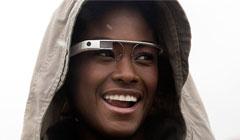Not long ago, Google filed a
patent for pay-per-gaze technology. The technology, which allows Google to assign advertising revenue to content providers based on a reader’s glances, is big news for content providers who are tired of giving up free space to advertisers. But it may be a lot more impactful than that. The obvious weakness of the pay-per-gaze framework, other than privacy, is that it requires an always-on camera -- if you think real-time monitoring of a user’s eye-movement while they browse the Web sounds creepy, that’s because it is. An alternative to having a camera perpetually pointed at the user is to have a camera that shoots from a person’s point of view – preferably from their eye level. Not only would it moderately improve the privacy situation but it would require much cheaper components and would be a good deal less work to program. Instead of incorporating a camera accurate enough to capture subtle eye movements in lighting conditions that would, as often as not, be sub-prime, the gaze could be calculated based purely on the position of the user’s head and a sweet spot in the camera field.
Adding Glass to the Equation
While the patent doesn’t specifically mention Google Glass, the wording of one passage strongly suggests it’s part of the equation:
Eyeglasses including side-arms that engage ears of the user, a nose bridge that engages a nose of the user, and lenses through which the user views the external scenes, wherein the scene images are captured in real-time.

Thus far, Google Glass has been demonstrated predominately as an action cam with a few fancy extra features. It has the potential to be a whole lot more, but whether it reaches that potential will largely depend on the public’s acceptance of people walking around with cameras on their faces. And there’s already been backlash: Several watering holes have banned Google Glass, and Google itself has put the kibosh on the development of apps with facial-recognition properties out of privacy concerns. Google Glass is more of a head-up display than an augmented reality solution. It provides a digital overlay for the physical world – which makes for some very interesting location-related possibilities. It’s already location-aware, so why not make advertising location-specific? We already see geo-targeted ads, but this could be much more tightly focused. Imagine yourself downtown in a big city at 5 p.m. Your search history indicates that you might be looking for a new laptop. You wander the streets and an ad pops up that shows that the model you had your eye on is on sale at an electronics store around the corner. Would you walk in? I probably would. So you go in, do some window-shopping. Time passes and it is now 6:30 – a time when most people are thinking about getting something to eat. You exit the store, look to your left, and several ads pop up for restaurants in your vicinity. You eat, leave the restaurant at 8:00, this time you see ads for bars. When you stumble out of the bar in the early hours of the morning, it points you toward a taxi stand.
The Trouble with Google Glass
While the patent may suggest integration with Google Glass, don't expect to start seeing the new feature anytime soon. Google Glass has a couple of fairly significant problems that need to be addressed before it can happen. First and foremost is the price: The Explorer unit comes in at a wallet-breaking $1000 – far too expensive for most people. Secondly, people aren’t used to seeing Google Glass, so it looks kind of silly. A lot of people would be embarrassed to wear it. These problems aren't unrelated. If you get Google Glass onto more faces, people will get used to it and it‘ll seem less silly. To do that, Google needs to sell more. A lot more.
The Unimaginative But Likely Solution
How can Google get Glass onto more heads? As discussed, it needs to be cheaper. So they sacrifice on the components, improve production output or subsidize and take a hit on each unit sold. An advertising supported pricing model would offer a partial solution – but realistically, how much revenue can one person generate in a year? With the present model of Internet advertising the answer is, “not a lot.” But the Glass environment allows all kinds of parameters around the advertisement to be tweaked to make the ads in question much more effective. We already have location-based advertising, but there is a huge difference between a potential customer sitting behind his or her desk, and a potential customer who is on the move. As such, pay-per-gaze Glass advertisements would hold much greater value than typical AdSense offerings. If ad prices were increased and an individual could generate more ad revenue, it does seem feasible that advertising could subsidize the cost of Google Glass. If you couple that with savings made through volume production and throw a carrier subsidy on top, Google Glass would almost be affordable. Offer a subscription service like cell phones, and people would forget how much they’re actually paying.
The Road Ahead
Google has something of a chicken/egg conundrum on its hands. It needs customers to support its ad model so that it can drive revenue but to get those customers, Glass needs to be more affordable. Google cash reserves may seem like an appealing solution, but jump-starting the market before people are ready would just be silly. Their money would be better spent on marketing and promotion than subsidies. That and a moderate price cut could help Glass gain a little traction – enough that pay-per-gaze would start to become a viable option. Once that happens, everything has the potential to hit critical mass. All things considered, if I had shelled out the $1,000 that Glass costs now, I would be pretty disappointed if there was no way to enjoy an ad-free experience. With that in mind, Google needs to think very carefully about the sort of experience it will offer. The right kind of ads can be useful, but there’s a time and a place for everything. If Google's successful in finding the very fine balance between utility and annoyance, pay-per-gaze could be a huge success.
 Thus far, Google Glass has been demonstrated predominately as an action cam with a few fancy extra features. It has the potential to be a whole lot more, but whether it reaches that potential will largely depend on the public’s acceptance of people walking around with cameras on their faces. And there’s already been backlash: Several watering holes have banned Google Glass, and Google itself has put the kibosh on the development of apps with facial-recognition properties out of privacy concerns. Google Glass is more of a head-up display than an augmented reality solution. It provides a digital overlay for the physical world – which makes for some very interesting location-related possibilities. It’s already location-aware, so why not make advertising location-specific? We already see geo-targeted ads, but this could be much more tightly focused. Imagine yourself downtown in a big city at 5 p.m. Your search history indicates that you might be looking for a new laptop. You wander the streets and an ad pops up that shows that the model you had your eye on is on sale at an electronics store around the corner. Would you walk in? I probably would. So you go in, do some window-shopping. Time passes and it is now 6:30 – a time when most people are thinking about getting something to eat. You exit the store, look to your left, and several ads pop up for restaurants in your vicinity. You eat, leave the restaurant at 8:00, this time you see ads for bars. When you stumble out of the bar in the early hours of the morning, it points you toward a taxi stand.
Thus far, Google Glass has been demonstrated predominately as an action cam with a few fancy extra features. It has the potential to be a whole lot more, but whether it reaches that potential will largely depend on the public’s acceptance of people walking around with cameras on their faces. And there’s already been backlash: Several watering holes have banned Google Glass, and Google itself has put the kibosh on the development of apps with facial-recognition properties out of privacy concerns. Google Glass is more of a head-up display than an augmented reality solution. It provides a digital overlay for the physical world – which makes for some very interesting location-related possibilities. It’s already location-aware, so why not make advertising location-specific? We already see geo-targeted ads, but this could be much more tightly focused. Imagine yourself downtown in a big city at 5 p.m. Your search history indicates that you might be looking for a new laptop. You wander the streets and an ad pops up that shows that the model you had your eye on is on sale at an electronics store around the corner. Would you walk in? I probably would. So you go in, do some window-shopping. Time passes and it is now 6:30 – a time when most people are thinking about getting something to eat. You exit the store, look to your left, and several ads pop up for restaurants in your vicinity. You eat, leave the restaurant at 8:00, this time you see ads for bars. When you stumble out of the bar in the early hours of the morning, it points you toward a taxi stand.


